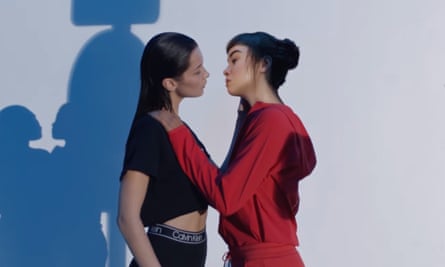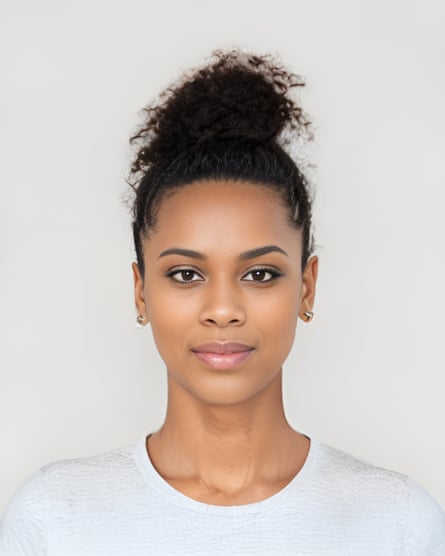Computer-generated inclusivity: fashion turns to ‘diverse’ AI models | Fashion

The star of Levi’s new marketing campaign seems to be like any other model. Her tousled hair hangs in excess of her shoulders as she gazes into the digicam with that much-off superior-trend stare. But look closer, and something begins to appear to be a very little off. The shadow between her chin and neck appears to be muddled, like a negative attempt at using FaceTune’s eraser influence to conceal a double chin. Her French-manicured fingernails look scrubbed clean up and uniform in a creepy real doll sort of way.
The product is AI-generated, a electronic rendering of a human being that will begin showing on Levi’s e-commerce web site afterwards this yr. The brand name teamed with LaLaLand.ai, a electronic studio that makes custom made AI designs for firms like Calvin Klein and Tommy Hilfiger, to desire up this avatar.
Amy Gershkoff Bolles, Levi’s world head of digital and emerging technologies strategy, declared the model’s debut at a Enterprise of Trend function in March. AI designs will not absolutely swap the human beings, she claimed, but will provide as a “supplement” meant to assist in the brand’s representation of many measurements, skin tones and ages.
“When we say health supplement, we suggest the AI-created designs can be used in conjunction with human types to potentially grow the selection of types for every item,” a Levi’s spokesperson said. “We are psyched about a environment the place consumers can see more designs on our site, potentially reflecting any mixture of physique type, age, measurement, race and ethnicity, enabling us to make a much more personalized and inclusive shopping experience.”
Michael Musandu, the founder of LaLaLand.ai, produced the program in aspect for the reason that he struggled to locate versions who look like him. He was born in Zimbabwe, lifted in South Africa, and moved to the Netherlands to study laptop or computer science. “Any excellent technologist, as an alternative of complaining about a dilemma, will make a future where you could actually have this representation,” Musandu said.
What about simply selecting a varied forged of styles? Musandu claimed that LaLaLand.ai is not meant to “replace” styles, but allow for makes to manage displaying off diverse garments on as several bodies as feasible.
“It is not possible for brands to shoot nine versions for every solitary item they sell, due to the fact they’re not just choosing styles, they are using the services of photographers, hair stylists and makeup artists for those people types.” AI-generated visuals really do not will need glam squads, so models can slash charges they would spend on set by employing pretend avatars.
A spokesperson for Levi’s included: “The products Levi’s hires are previously diverse and this will proceed to be a priority for us. More than the past 12 months, we’ve been focused on guaranteeing that those people operating on the material both equally in entrance and at the rear of the digital camera are reflective of our broad purchaser foundation.”
However the range that AI can give is often heading to be virtual – a laptop-generated feeling of inclusivity. Are manufacturers who generate, for example, black styles for items where they only photographed a white human model partaking in a type of electronic blackface?
This is not a new question. There are previously “digital influencers” like Lil Miquela and Shudu, pretend avatars with thousands and thousands of followers on social media. They design Prada, Dior and Gucci outfits with the idea that their (human) viewers will acquire the parts. Neither design is white, but both have at the very least just one white creator (Shudu was designed by British fashion photographer Cameron-James Wilson and Miquela by Trevor McFedries and Sara Decou).
Criticism of Levi’s for casting AI types rather of true types echoes the wave of response Lil Miquela got when she was very first released in 2016, or when Shudu manufactured her debut two several years later on. The New Yorker’s Lauren Michele Jackson named Shudu “a white man’s digital projection of authentic Black womanhood”.
Lil Miquela’s creators also stuffed her pretend everyday living with “events” to consider to give her individuality. Calvin Klein apologized for a Pride advertisement that confirmed Lil Miquela kissing the serious model Bella Hadid. A couple of months afterwards, Lil Miquela arrived out with a story of experiencing sexual assault in the again of a ride-share, and followers accused her creators of making up a traumatic celebration for clout.

In contrast to their mortal counterparts, these versions also by no means age. Miquela, a “19-calendar year-outdated Robotic living in LA”, is for good 19 – creating her a warm commodity in a youth-obsessed field.
Deep Company, a further Netherlands-centered AI corporation, created headlines this thirty day period soon after debuting its personal “AI modeling agency”. The support, which fees $29 a month, models itself as a way for creators to “say goodbye to regular photoshoots”. People kind in description for what they want their photo to seem like, and receive “high-quality” pictures of fake versions in return.
Paid subscribers of the provider attain entry to 12 versions of several races, although all show up to be lesser-bodied and in their 20s and 30s. People browse via the site’s catalog of existing images, which contain pictures of versions participating in pursuits like looking at guides or offering the digicam a peace signal. These images provide as the inspiration for the last consequence.

In a photograph rendered by the Guardian, a single model named “Chai” experienced an unnervingly plastic-seeking confront and further-extensive, slender fingers that belonged in a horror movie. An additional, “Caitlin”, had a concerning sum of veins popping out from below the pores and skin of her neck. A male product, “Airik”, seemed very awkward and stick-straight as he posed in entrance of a drab grey creating.
How extensive prior to these models are getting away careers from genuine folks? Sara Ziff, founder of the advocacy group The Design Alliance,is anxious, “capitalizing on someone else’s identification to the exclusion of using the services of individuals who are basically Black could be when compared to Blackface”, Ziff reported.

Ziff’s New York business office hosts a assist line exactly where models contact in to explore items that have manufactured them awkward on set. Recently, the subject of discussion has been AI, and precisely overall body scans, which models can use to make digital, 3D replicas of models’ bodies.
“We’ve acquired an increasing number of phone calls from products who soon after receiving entire body scans uncovered that the legal rights to their system were currently being assigned to a company, which intended that they ended up losing the legal rights to their personal graphic,” Ziff reported. “We’ve especially listened to this from in good shape products, who are worried around how their own information and facts would be utilized or capitalized on without the need of their authorization.”

Match products operate in the first method of trend structure. They are primarily human mannequins for creatives, who attempt on drafts of outfits to see how the garment appears to be like on a genuine overall body.
Summer time Foley, a 25-year-old product in New York, explained it was not unusual to make about $400 an hour as a fit product.
“If an individual required to scan my human body, I’d want to demand them every time they used it!” Foley explained. “That’s my body, and I operate challenging to keep these measurements. You cannot make a scan of me and use my likeness in perpetuity without the need of me making any revenue.”
Sinead Bovell has modeled for 6 years and wrote about the topic of AI products for Vogue in 2020. She routinely posts on social media about the ethical problem that comes with firms employing models’ bodies to produce their images.
Final 12 months, the portrait app Lensa went viral for building hugely stylized portraits of buyers. It utilised Secure Diffusion, a textual content-to-image application that is skilled to master patterns through an on-line databases of pictures. Those images are sourced from throughout the internet, which led to artists stating Lensa was stealing their operate to make the pics.
Equally, manufacturers could teach their AI on authentic-lifetime images or overall body scans of human products. But who gets compensated when the image created from their likeness lands the up coming big advert marketing campaign? “Who would own that details? The place would it stay? I’m absolutely sure there are ways that you have complete rights around it, but as that space of tech is becoming ironed out, I’d instead not be the guinea pig,” Bovell reported.
Musandu, the LaLaLand.ai founder, mentioned that his algorithm only works off facts that the organization owns. But he agrees that firms need to compensate types if they foundation imageson their likeness. “I think if any algorithm has made use of you in the training set, you should really have the legal rights for licensing those people pictures,” he explained.
It is easy to continue to be pessimistic about the prolonged-time period affects this will have of trend and body graphic. “I can see a upcoming with AI exactly where elegance specifications become even additional unrealistic because apparel is pretty much worn by individuals who are not authentic,” Bovell reported. “If you seem at the historical past of how tech has evolved – issues like selfie sand filters – it’s not tremendous constructive.”
Bovell, who is Black, does not think that anyone can only create a digital identity that displays their own. But she problems about the ethics of who will finally profit from images of types of coloration. “I get in touch with that robotic cultural appropriation,” she explained. “The main question is: who has the proper to individual and discuss on identities that AI versions symbolize?”

.png)


